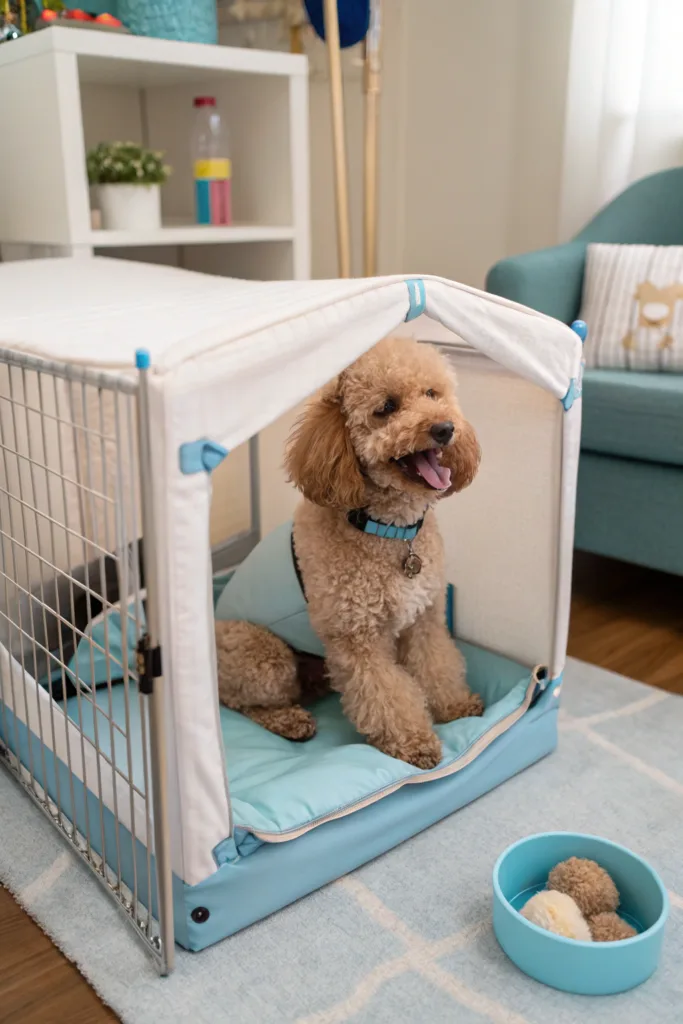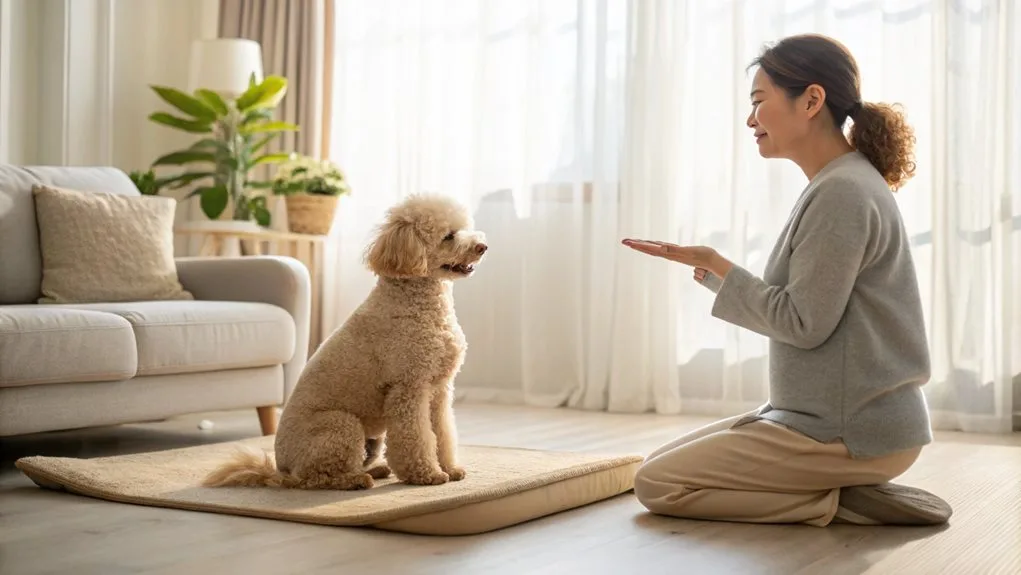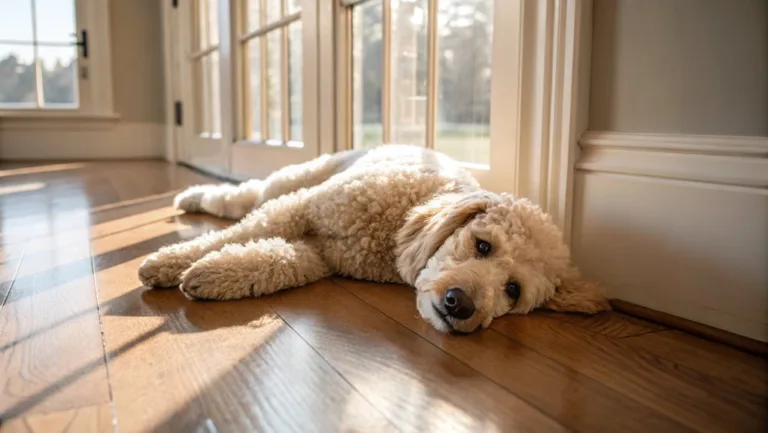10 Best House Training Tips For Your Teddy Bear Poodle

House training your Teddy Bear Poodle isn’t just about avoiding messes—it’s about building a lifelong bond of trust and communication.
You’ll quickly discover that these adorable, compact companions require a strategic approach that balances patience, consistency, and understanding. While their tiny size might seem like a training challenge, the right techniques can transform potential frustration into a rewarding journey.
What if you could reveal the secrets to a perfectly house-trained pup, turning those initial bathroom mishaps into a distant memory? Stick around, and you’ll learn how to navigate this critical phase with confidence and ease.
Key Takeaways
- Establish a consistent routine with frequent potty breaks every 1-2 hours, especially for small Teddy Bear Poodles with limited bladder capacity.
- Use positive reinforcement by rewarding successful outdoor eliminations immediately with high-value treats and enthusiastic verbal praise.
- Create a designated potty area near your home and guide your puppy there consistently using the same pathway and verbal cues.
- Implement crate training to help manage bathroom schedules and prevent indoor accidents when direct supervision isn’t possible.
- Monitor and track bathroom patterns by maintaining a detailed log to understand your Teddy Bear Poodle’s individual elimination needs and behaviors.
1. Establish a Consistent Daily Routine

House training a Teddy Bear Poodle starts with establishing a consistent daily routine that helps your puppy learn when and where to eliminate.
Your goal is to create a predictable schedule that aligns with your puppy’s physical development and bladder control. Poodles’ bladder control develops gradually, with puppies typically needing frequent bathroom breaks based on their age and physical capabilities.
Toy breed puppies require extra attention due to their small delicate bladders, which can contribute to health challenges if not properly managed.
Begin by setting specific meal times that correspond with potty breaks. A general rule is that your puppy can hold their bladder for approximately one hour per month of age. For instance, a two-month-old Teddy Bear Poodle will need potty breaks every two hours.
Smaller bladders require more frequent attention, making it crucial to monitor your puppy’s bathroom needs closely.
Take your puppy outside immediately after meals, using consistent voice commands like “go potty” to reinforce the desired behavior. Regular vet visits are also important for monitoring their overall health, including genetic factors that may influence bladder control.
Your daily routine should include frequent potty breaks, ranging from every one to three hours. Establish a morning routine where your puppy is taken outside until they’ve both urinated and defecated.
Always reward successful elimination with praise and treats to encourage positive habits.
Incorporate structured playtime and rest periods using playpens or designated areas. At night, place the puppy’s crate near your bed and plan for one or two nighttime potty breaks.
Consistency is key to successful house training.
2. Master Leash Training Techniques

Mastering leash training is essential for your Teddy Bear Poodle’s safety and social development. Your success depends on a methodical, patient approach that transforms walking from a challenge to an enjoyable experience.
Key considerations for effective leash training include:
- Proper equipment fit and comfort
- Consistent positive reinforcement
- Gradual exposure to distractions
Begin by introducing the collar or harness indoors, allowing your poodle to associate it with positive experiences. Start with short, supervised sessions where the dog wears the equipment, rewarding calm behavior with treats and praise.
Breed-specific energy levels make Poodles particularly responsive to structured training approaches. Their protective nature enhances their alertness during walks, making leash training even more vital.
Once comfortable, attach a lightweight leash and let your poodle drag it around under your watchful eye. Balanced training methods provide a comprehensive approach to teaching leash manners through gentle corrections and consistent rewards.
Equipment selection plays a crucial role in successful leash training, as the right collar or harness can significantly impact your dog’s learning process.
When training, choose a quiet environment to minimize distractions. Apply gentle leash pressure and immediately reward even slight compliance. Practice basic commands like “heel” and “sit,” changing directions to maintain your dog’s focus.
Consistent reinforcement techniques can help establish clear communication between you and your poodle during training sessions.
Stop walking if pulling occurs, waiting for your poodle to return to your side before continuing. Canine learning psychology suggests that dogs respond best to clear, consistent training signals that reinforce desired behaviors.
As skills improve, gradually introduce more challenging environments. Progress from indoor training to your backyard, then quiet parks, always maintaining consistent commands and rewarding good behavior.
3. Create a Comfortable Crate Space
A well-designed crate serves as your Teddy Bear Poodle’s secure sanctuary, providing a safe haven for rest, training, and personal space.
Choose a crate that allows your puppy to stand, turn, and lie down comfortably, ensuring proper ventilation and easy cleaning.
Crate comfort helps prevent the dog from viewing the crate as a negative space, which can disrupt potty training efforts.
Additionally, a well-ventilated crate can contribute to your puppy’s overall skin health, making it a more comfortable environment.
Position the crate strategically in a quiet area near your bed, avoiding drafty spots and high-traffic zones.

This placement helps reduce stress and facilitates nighttime potty breaks.
Use dividers to adjust the space as your puppy grows, creating an adaptable living environment.
Make the crate inviting by adding a soft, washable bed and providing engaging toys. Use treats to create positive associations, encouraging your puppy to view the crate as a welcoming space rather than a punishment.
A secure latch prevents escape attempts while maintaining your puppy’s safety.
Integrate crate training into your routine by using it to manage your puppy’s environment when unsupervised. Establish a consistent schedule of crate time after meals, drinking, and play to support potty training.
Remember to gradually increase crate time and always provide breaks to prevent training regression.
4. Use Positive Reinforcement Rewards

Positive reinforcement transforms teddy bear poodle house training from a challenging task to an enjoyable bonding experience. By understanding how rewards work, you’ll create a supportive learning environment for your furry companion.
Operant conditioning research demonstrates that dogs learn most effectively through positive reinforcement techniques. Consistent feeding schedules help establish predictable elimination patterns that support training success.
Here are key strategies to implement:
- Select high-value rewards like small treats or favorite toys.
- Time rewards immediately after desired behavior.
- Use consistent verbal praise like “good boy/girl.”
When training your teddy bear poodle, choose rewards that genuinely excite them. Each dog has unique preferences, so experiment to find what motivates your pup most effectively. The goal is to make successful bathroom breaks and obedience feel rewarding.
Additionally, understanding the importance of early socialization can significantly enhance your poodle’s learning experience.
Timing is critical in positive reinforcement. Give treats or praise within seconds of the desired action to help your poodle understand exactly what behavior earned the reward.
A verbal affirmation like “good potty” paired with a treat helps create a clear connection.
Consistency is your greatest ally. Avoid punishment or negative reactions to accidents, as these can create fear and hinder training progress. Instead, focus on celebrating successful moments.
Your calm, encouraging approach will help your teddy bear poodle learn quickly and build a strong, trusting relationship.
5. Recognize Potty Behavior Signals

Every successful house training journey begins with understanding your teddy bear poodle’s unique potty signals.
Knowing these cues can prevent accidents and help establish a consistent bathroom routine.
Early recognition of these signals can significantly reduce training time and frustration. Training consistency matters
Watch for key behavioral indicators like sniffing and circling, which strongly suggest your pup needs to go outside.
When your poodle starts walking while squatting or becomes restless and shaky, it’s time to head to the designated potty area immediately.
It’s important to remember that poodle growth milestones can affect their bladder control as they mature.
Pay attention to body language, such as sitting by the door or staring at you with a sense of urgency. Bladder size limitations mean smaller dogs require more frequent bathroom breaks, so staying vigilant is crucial.
Timing plays a vital role in potty training. Take your teddy bear poodle out after meals, naps, and within 10-15 minutes of drinking water. Small breeds like toy poodles have smaller bladders, so frequent outings are essential.
Implement a consistent schedule, aiming to take your pup out every 30 minutes during training. Verbal cue consistency helps your poodle understand when and where to eliminate.
Vocal cues are equally important. Whining, barking, or scratching at the door are clear signals that your poodle needs to go. Consider bell training to improve communication.
6. Select the Perfect Potty Area

During the early stages of house training your teddy bear poodle, selecting the perfect potty area becomes a vital foundation for success. Your choice of location will substantially impact your training effectiveness.
Consider these key factors:
- Consistency matters
- Weather plays a role
- Supervision is essential
When choosing a potty spot, pick a specific, easily accessible area near your house. This location should remain constant to help your poodle recognize and associate it with bathroom breaks.
Make sure the surface is comfortable and free from distractions or hazards.
Weather conditions matter, so select an area that provides some shelter and comfort. In colder temperatures, be prepared with appropriate dog clothing to keep your teddy bear poodle warm during potty breaks.
Use visual and olfactory cues to reinforce the designated area. Always supervise your poodle during bathroom time, using a leash to guide them to the correct spot. This “umbilical approach” helps maintain control and consistency in training.
Remember to reward your poodle immediately after they successfully use the potty area, creating a positive association with the designated location. Your patience and methodical approach will guarantee successful house training.
Incorporating positive reinforcement methods will further enhance the training experience for your teddy bear poodle.
7. Prevent and Handle Bathroom Accidents

Most teddy bear poodle owners will encounter bathroom accidents during the house training process, making prevention and proper handling critical to successful training.
By establishing a consistent routine and implementing strategic techniques, you’ll minimize indoor mishaps and accelerate your puppy’s potty training.
| Age | Bladder Capacity | Potty Frequency | Training Focus |
|---|---|---|---|
| 8-10 weeks | 1-2 hours | Every 1-2 hours | Supervised, frequent breaks |
| 3-4 months | 3-4 hours | Every 3-4 hours | Crate and leash training |
| 4-6 months | 4-6 hours | Every 4-6 hours | Consistent routine |
| 6+ months | 6-8 hours | Every 6-8 hours | Independent elimination |
Controlling food and water intake helps predict bathroom needs. Take your puppy outside within 5-30 minutes after meals, using a leash to guide them to the designated potty spot.
When accidents occur, clean them immediately without punishment, as scolding can create anxiety and worsen the problem. Understanding your poodle’s barking triggers can also help create a calm environment that supports successful house training.
Utilize crate training to leverage your puppy’s natural den instincts, and consider bell training to improve communication.
Remember, patience and consistency are key to successful house training. Reward correct behavior and maintain a structured routine to help your teddy bear poodle learn quickly and effectively.
8. Choose Appropriate Training Treats

Carefully selecting the right training treats can substantially impact your teddy bear poodle’s learning experience and overall health.
When choosing treats for your furry friend, consider these key factors:
- Nutritional value
- Digestibility
- Size and consumption ease
Your puppy’s treats should be more than just rewards—they’re vital training tools.
Opt for high-quality treats made from whole meats, natural ingredients, and specifically formulated for small-breed puppies.
Poodles possess hair, not fur, which means they require careful consideration when selecting treats to ensure they do not cause digestive issues.
Look for options containing animal-based proteins, Omega 3&6 fatty acids, and natural preservatives to support your pup’s development. Puppy treat selection requires understanding that different stages of growth demand unique nutritional approaches.
Prioritize treats that are easy to digest and won’t upset your puppy’s sensitive stomach. Soft, bite-sized options work best during training sessions, allowing quick consumption without disrupting focus.
Clicker training techniques suggest breaking treats into tiny pieces to maintain puppy engagement and prevent rapid satiation.
Avoid treats with fillers, by-products, or potential allergens that could cause digestive issues.
Pay close attention to portion control. Track the number of treats given during training to prevent overfeeding and maintain a balanced diet.
Use treats with strong aromas to keep your teddy bear poodle engaged, but guarantee they complement—not replace—regular meals. Small breed puppies require precise nutritional management to support their rapid growth and metabolic needs.
9. Maintain a Patient Training Approach

House training your teddy bear poodle requires a patient, strategic approach that recognizes the unique learning curve of these intelligent yet sensitive dogs.
You’ll need to understand that puppies aren’t programmed machines, but learning individuals who develop skills at their own pace.
Consistency is your most powerful training tool, helping your poodle adapt to new routines without feeling overwhelmed.
Remember that patience isn’t just about tolerating mistakes—it’s about creating a supportive learning environment. When accidents happen, resist the urge to punish. Negative reinforcement will only make your poodle anxious and potentially hide future bathroom behaviors.
Instead, focus on immediate positive reinforcement. Praise and reward your poodle instantly when they successfully use the designated potty area. Regular exercise is crucial; daily exercise helps burn energy, which can lead to fewer accidents indoors.
Your training approach should be methodical and structured. Establish a strict schedule for the first few weeks, incorporating regular potty breaks, consistent cue words like “Outside” or “Potty”, and immediate rewards.
Set a timer to help you maintain a routine, and gradually increase the time between outings as your poodle matures.
10. Track Puppy’s Bathroom Progress

Systematically track your teddy bear poodle’s bathroom habits to guarantee effective house training progress. Documenting your puppy’s elimination patterns is vital for successful potty training.
Here are three key tracking strategies:
- Create a detailed bathroom log noting:
- Time of day
- Location of elimination
- Duration between potty breaks
- Any accidents
Maintaining an exhaustive record allows you to identify patterns and predict your puppy’s bathroom needs. You’ll quickly recognize when your teddy bear poodle is most likely to require a potty break, enabling proactive intervention and reducing indoor accidents.
Your tracking should include rewards and setbacks. Celebrate successful outdoor eliminations by immediately praising and treating your puppy.
Conversely, when accidents occur, note the circumstances without creating negative emotional associations.
As your puppy grows, you’ll naturally adjust the tracking frequency. Initially, monitor closely with frequent documentation. Gradually, you’ll shift to less intensive tracking as your teddy bear poodle becomes more reliable.
The goal isn’t perfection but consistent improvement. By methodically tracking progress, you’ll develop a nuanced understanding of your puppy’s bathroom habits, ultimately ensuring a well-trained, confident companion.
Additionally, understanding your puppy’s exercise needs is important, as it can influence their bathroom schedule and habits.
Frequently Asked Questions
How Long Does House Training a Teddy Bear Poodle Typically Take?
You’ll typically need 4-6 months to house-train your Teddy Bear Poodle, depending on consistency, routine, and the puppy’s individual bladder control development. Smaller dogs may require more patience and time.
Can I Use Puppy Pads During the House Training Process?
You can use puppy pads during house training, but be strategic. They’re convenient for indoor training, yet shift carefully to prevent pad dependence and guarantee successful outdoor potty habits.
What Age Is Best to Start Potty Training My Puppy?
You can start potty training your puppy as early as 8 weeks old. At this age, they’re developmentally ready to learn, with increasing bladder control and receptiveness to establishing consistent bathroom routines.
How Often Should I Take My Teddy Bear Poodle Outside?
You’ll need to take your puppy out every 2-3 hours initially, following the month-plus-one rule. Adjust frequency as they grow, always maintaining consistent timing after meals, playtime, and waking up.
Are Male and Female Teddy Bear Poodles Different to Train?
No significant differences exist in potty training male versus female Teddy Bear Poodles. You’ll find that consistent methods, positive reinforcement, and individual puppy characteristics matter more than gender during house training.
Conclusion
Successfully house training your Teddy Bear Poodle requires dedication, patience, and consistent technique.
By implementing these strategic methods, you’ll transform potential challenges into rewarding learning experiences. Remember, every accident is an opportunity to refine your approach.
Stay positive, maintain a structured routine, and celebrate small victories. Your commitment will create a well-trained companion who understands bathroom expectations and thrives in your loving home.






